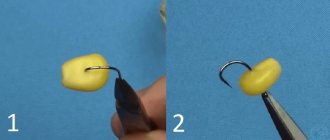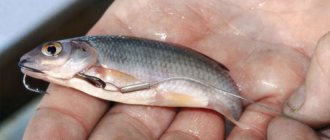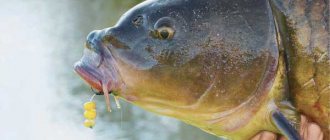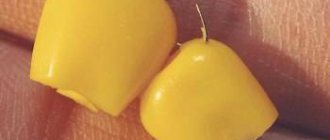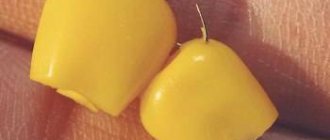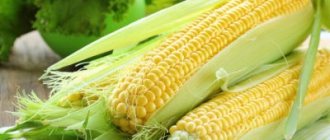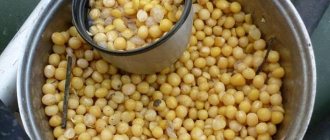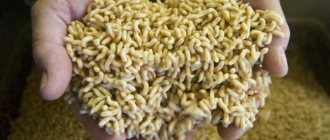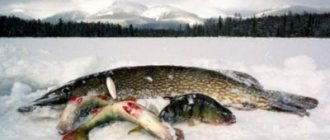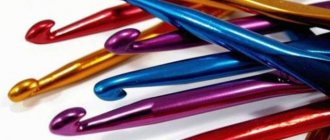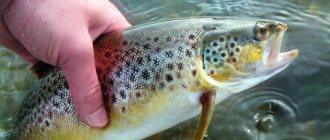Float rod
A float rod is used to catch carp up to 2 kg.
Tackle for a float rod includes the following accessories:
- Rod.
- Coil.
- Hook.
- Fishing line.
- Leash.
- Float.
- Small weight.
- The optimal length of a fishing rod for catching carp is 3.5 – 4.5 meters. Shorter fishing rods will not be able to tire this fish, and longer ones will be inconvenient to hold when playing.
- The most suitable reel for a float fishing rod is considered to be a spinning reel with a friction clutch and a baitrunner. Its size should be at least 3500-4000.
- It is better to take a hook from number 10 with a short but sharp shank. You also need to ensure that the hook is made of high-quality material.
- A monofilament with a diameter of 0.3-0.35 mm is suitable as the main fishing line. Also, the fishing line must withstand a weight of up to 15 kg and be at least fifty meters long.
- For a leash, a piece of fishing line with a thickness of 0.28-0.32 mm and a length of 22 to 25 cm is suitable.
- It is better to choose a light float with high sensitivity.
- A small weight is suitable, since carp are caught in a weak current. The best option would be a gray weight in the shape of an olive or an arrow.
Recipe for bait with corn for carp
When preparing corn for fishing, there are no clearly defined boundaries in the recipe. Each fisherman has his own signature recipe and opinion on how to make the most of the capabilities of this type of bait. But still, the main stages of preparation are common to everyone.
For cooking, follow these rules:
- We prepare the grains. The grain separated from the corn cobs is washed and soaked overnight in hot water. The soaking time can be increased, but it should not be reduced.
- Let's cook.
Before adding corn to cook, fresh water must be sweetened. You can use sugar syrup or honey for this. It takes about 40-50 minutes to reach readiness. - We drain the water into a separate container, and pour the grains into a regular three-liter jar. Sweeten the sweet corn broth again, add a pack of dry yeast and a few tablespoons of beet molasses.
- Fill the grain with the resulting solution so that the water level is 10 cm higher.
- Close the jar and give the yeast time to ferment properly. It is worth considering that corn increases in size when infused, which means it is worth leaving 1/3 of the container volume unfilled.
- After three days, we drain the water; it is no longer needed. Pour the grains into a convenient plastic container. Now you can go after your catch.
If you just need to boil the corn, then:
- dry grains are soaked for a day in clean water;
- when cooking, they are kept in boiling water for about half an hour, the water must be sweetened;
- Corn is stored in the syrup in which it was boiled.
Corn prepared in this way resembles the ready-made canned product from the store.
Feeder
The feeder method is used to catch heavy fish (more than 2 kg) over a long distance. The advantage of feeder fishing is that it allows you to fish in the most distant water zones from the shore, while focusing only on one section of the reservoir, which is pre-fed.
The most suitable gear for fishing on a feeder:
- A rod up to 3.5 m long with a weight of 70 to 100 grams.
- Durable reel size 2700-3500.
- Monoline or braided line with a diameter of 0.35 mm.
- Leashes made of fishing line with a diameter of 0.2 mm and a length of 40 to 70 cm.
- Paternoster feeder or anti-twist tube. You can choose a feeder at your own discretion, since there are no special criteria for its selection.
- Sharp hook with classic numbers 6-8.
What kind of corn can be used to catch carp?
Corn is considered an indispensable vegetable bait for carp fish, as it has the following advantages:
- When cooking corn, you can achieve the desired degree of softness or hardness of the grains.
- This type of attachment is several times cheaper than other artificial attachments.
- Almost any type of flavoring can be applied to corn, making it attractive to many types of fish.
- The corn is securely attached to the hook and does not dissolve in water.
- General availability of grains.
- It has an attractive aroma, color and shape, which is always very popular with most fish.
Disadvantages of using corn:
- A large amount of this complementary food can saturate the carp, after which it simply will not peck at the bait with the delicacy offered to it.
- Carp is not the only fish that doesn’t mind profiting from corn, so you can expect a bite from asp, bream, rudd and others, but this is more a plus than a minus.
To catch carp you can use the following types of corn:
- Store-bought canned (from a jar).
- Boiled.
- Young and fresh.
- Fermented.
Main benefits gained from the use of corn
Regardless of the form in which corn is used for fishing, its appearance, color and aroma always remain attractive to carp. You can purchase this bait in sufficient quantities at any grocery store (canned corn).
Corn grains stick well to the hook, and it is very difficult for small fish to knock them down. Since large hooks are used in the equipment, the likelihood that small crucian carp or roach will swallow the bait is reduced to zero, only carp and only large ones.
When fishing with canned corn, you don’t need to use flavorings; all you need to do is open a jar, take a few grains (3-5 pieces) and place them on the tip of a hook or hair.
If you prepare the bait (corn) yourself, you can easily obtain any desired degree of grain hardness.
The choice of bait should be made based on the fishing conditions, so medium-hard grain is more suitable for currents, and soft for calm water. The advantage of the latter is that it can be easily attached to a hook; it is recommended to attach hard grain only to hair.
Canned corn
Canned corn is very often used by fishermen recently because:
- It is inexpensive and can be stored for quite a long time in the refrigerator.
- Carp always reacts well to it.
Cons of canned corn:
- In some manufacturers it is very hard and does not fit well on the hook.
- It may be tasteless and not attract fish with its aroma.
The use and selection of suitable canned corn has its own characteristics:
- When purchasing canned corn, you should choose only the hard varieties as they will hold better on the bait.
- The kind of corn that a person likes to taste may not necessarily attract carp.
- It is better to buy canned corn in specialized stores, where flavors and dyes are added to it, which will attract the attention of carp. If you cannot find such corn, then the companies Bonduelle and Vernet are considered the best producers of canned grains, since their product is easily hooked due to its softness and the fish bite well on them.
In order for canned corn to be as effective as possible, the following methods should be used:
- Add a little essence to the grains with the aroma of sweet berries, vanilla, and honey. For catching in the autumn, it is recommended to use flavor enhancers with the aroma of shrimp or meat.
- You can dip each kernel of corn in the flavoring just before putting it on the hook.
- It is advisable to add a flavoring with the same smell that will be contained in the grains to complementary foods.
Young corn (raw) can also be used as bait. As a rule, well-aimed carp readily bite on such grains and do not feel threatened by the smell and taste of the yellow bait. It is important to know that it is young corn or “milk” that can be used, and not just already ripened grains. In addition, it is not advisable to add it to already cooked bait.
As for boiled and fermented corn, we will consider the features of their preparation separately.
"Sandwich" made from corn and worm
This method is slightly different from how to put corn on a hook for crucian carp or bream. Moreover, a combination of corn and a worm will work on any fish at any time. That is, this is a universal fishing method. Most often, one or two kernels of corn and a small worm are used. Each fisherman has his own bait options, let’s consider one of them.
Corn holds much stronger than the worm, so it is strung first. It is highly recommended to insert the point of the hook through the middle of the grain. Afterwards the worm is used. Its upper part has a wider base, so the point needs to be pulled through it. Next, use a hook to pierce the middle of the larva and pull it out through the tail. The result should be a ring that prevents the worm from falling off.
How to prepare corn for carp fishing
A fisherman can prepare the following corn on his own:
- Fermented.
- Boiled.
Fermentation
Fermented corn is made for bait or complementary food for carp fishing. This is a fairly effective product, the yellow color and aroma of which are very attractive even to such timid fish as carp.
To ferment corn for carp fishing you will need:
- Corn (3-4 kg).
- Water.
- Plastic containers with a lid that closes well.
- Boil the corn for forty minutes, then add a small amount of sugar.
- Pour the corn into buckets so that it fills them no more than one-third.
- Fill the corn with water so that its level is 15 cm above the grains. This is necessary so that the corn can absorb enough water and swell.
- Close the bucket with a tight lid and leave it to soak in a dark place.
- After the first three days, the corn will begin to ferment, foam and produce bubbles. In this case, you cannot open the buckets, since the process is not yet completed.
- After another five to six days, you can open the buckets. The smell of corn should be slightly alcoholic. In general, you can ferment corn for several months, this will not spoil it, but on the contrary, it will acquire an even more aroma that attracts carp.
- After this, you can use fermented corn, but you still need to store it in a closed bucket so that the smell does not dissipate again.
Cooking
Most fishermen prefer to use boiled corn rather than store-bought corn. The reasons for this are:
- Feeding corn may require about 6-8 kg, so using boiled corn is much cheaper than store-bought corn.
- Some fishermen are unhappy with the quality of store-bought corn because it is often overcooked, small, or squashed.
- Home-boiled corn can be sorted and large ones selected, which are most suitable.
- When brewing yourself, the fisherman can completely control the entire cooking process, and at the same time can also add various flavors at his discretion.
A step-by-step guide for making your own corn looks like this:
- Pre-soak the corn in water for three days.
- After this, pour the corn into a saucepan and add water with a small amount of honey or sugar (3-4 tablespoons), cook for 40 to 60 minutes. Cooking time depends on the type of corn and its “age”. The older the corn, the longer it takes to cook. It is important to know that the grains should not be overcooked, so during the cooking process it is necessary to check from time to time whether the future nozzle has already been cooked.
- After the grains are cooked, they must be left to steep in the same water for 2-2.5 hours. You can also add a flavoring with the smell of sweets or corn itself, which will additionally attract carp.
Which corn grains are suitable for planting?
You can use different corn for different baiting methods. So, only boiled is used for hair installation. The purchased one is too soft and will fall off at the first sharp cast. Otherwise, there are no strict rules; any corn can be placed on a regular hook, depending on the preferences of the fisherman. Below we will talk about the species and how they affect the bite.
Canned sweet
You can buy this at any grocery store. If you need to take corn in a can, then you should take it with the “sweet” mark on the label. The smell can attract crucian carp, carp and other fish. The most common and frequently encountered brands are “Bonduelle” and “Vernet”. But for fishing, any option, even the cheapest one, is suitable. Most fishermen believe that regular store-bought sweets are in no way inferior in quality to branded store-bought ones.
Canned food is convenient to use because the corn in them is ready for use immediately after purchase and does not require any additional processing. One of its disadvantages is that it does not sit well on the hook and can sometimes fly off it.
You can also make sweets at home. To do this, it is first left in water for two to three days. After this, the swollen grains are boiled for about thirty minutes; sugar, honey or other sweeteners are added during the cooking process. When cooking, you can check the degree of readiness by placing the corn on a hook and checking how it holds on it. When cooked, you can add vanillin or other flavorings to it. At the end, leave to infuse for a day. During this time, lactic acid is formed, which will also attract the attention of the fish.
Canned
Steamed
This type can be prepared in different ways. The first method: the grains are soaked in warm water for a day. The water is changed periodically (at least five times). The soaked grains are placed in a thermos, filling it one quarter full. At this point you can add flavoring. After this, the thermos is filled with boiling water and closed for 4 hours. The steamed corn is ready. If you don’t overexpose it, it will stick well to the sting.
The second method takes less time. First, the grains are boiled in boiling water for about ten minutes. After this, the water is drained from the pan, and the grains are poured into a thermos. Boiling water is poured into a thermos and left in this form until fishing begins. With this method, the grains are very hard and sit well on the hook. When fishing with such a bait, a very small part of the sting is exposed, so that it is easier for the fish to bite through the bait.
Steamed grains
Fermented boiled
The grains are soaked in water for a day. After they have settled, the water is drained and the corn is thoroughly washed. Water and sugar are poured into the pan in the proportion of 1 tablespoon to a liter of water. The grains are boiled in sweet water for about an hour. The water is drained from the pan, the grains are poured into a container with a narrow neck. A flavoring agent (honey, vanillin, coriander or any other of your choice) is added to the grains and the container is filled with cold water. To make fermentation go better, you can add a teaspoon of yeast. Access to air can be blocked by pouring a small amount of oil into the container. There is no need to close the container itself. The resulting mixture remains in a warm place for three to four days. Fermented boiled corn is ready. After this, it can be packaged and stored in the refrigerator. In this form it will retain its properties for about a month.
Fermented grains
Artificial
The artificial look imitates real plant grains, but, unlike them, is made of plastic. It may come straight out of the factory with a smell. If the artificial corn is odorless, the fisherman can choose the smell he wants on the spot using flavoring agents. Plastic grains hold well and have positive buoyancy. They are convenient to use on overgrown reservoirs with a muddy bottom.
Artificial bait can be used on a hair rig as a float that will lift the rest of the bait. This one can be used several times. Some manufacturers promise that the scent can last up to six hours.
Worth a try. sometimes helps
Branded
Can be found in specialized fishing stores. Sold in a large selection of scents and colors. It adheres to the tip very well and does not fly off during a sharp cast. This type is preferred by those fishermen who do not want to spend a lot of time preparing homemade bait.
Branded
How to use corn as bait
Recipe for corn bait No. 1
To prepare you will need:
- Canned corn (1 jar).
- Vanilla (2 teaspoons).
- Strawberry yogurt or fresh strawberries.
- Dry mixture for carp (2 kg).
Mix all the ingredients into a homogeneous mass and form small balls from them. Use immediately.
Recipe for corn bait No. 2
To prepare you will need:
- Boiled corn.
- Sugar (per 1 kg of corn - 2 tablespoons of sugar).
- Flavor with any sweet smell.
- Soak the corn for a day, then boil it in slightly sweetened water.
- After the grains are cooked, add flavoring with sugar and the bait is ready.
You should feed carp with corn in this way:
- The bait should be thrown into the reservoir a day before the intended catch.
- The total weight of complementary food should be at least 7-9 kg so that the carp can stay in one place for a long time.
- In the morning of the day of fishing and during the fishing process itself, it is also advisable to add complementary food in order to continue to keep the fish in the right place.
Secrets of successful fishing: choosing corn
Corn selection is a whole science.
Classification of cereals for fishing:
Food (sweet). Cans of corn should have o. Professionals prefer preservatives in glass jars, the Vernet and Bonduelle brands.
To make your own sweet corn you will need:
- raw grains;
- sugar;
- honey;
- cookware with enamel coating.
Cereals are soaked in raw water for 24-72 hours. The soaked cereals are boiled for 45-50 minutes, sugar and honey are added to taste, the grains should not be turned over.
The finished consistency is infused for 24 hours, the lactic acid released has an unpleasant odor, but the fish willingly takes the bait:
- Steamed. Cereals are soaked in warm water for 24 hours; the water must be changed at least 4-5 times a day. The soaked grains are poured into a thermos (no more than ¼ of the volume) and poured with boiling water for 4-5 hours. At the request of the fisherman, flavor enhancers and flavors are added. Overcooked corn falls off the hook easily.
- Fermented. The water-soaked grains are thoroughly washed with cold running water. A tablespoon of sugar is added per kilogram of corn and cooked for 45-60 minutes. The boiled grains are placed in a glass bottle. For effective fermentation, nutritional yeast is added and the resulting mixture is thoroughly mixed. In order to seal the consistency, the surface is filled with vegetable oil. The open bottle is left for 72-96 hours. The bait can be stored for up to 28 days at a temperature of +50C.
- Artificial. Plastic cereals imitate corn kernels. To achieve maximum effect, the use of flavorings is required. Advantages of artificial bait: buoyancy, reliable attachment to the hook, combination with baits as a float, reusable.
- Specialized. Fishing stores sell canned corn with the addition of specific flavors. However, the cost of the bait is tens of times higher than its consumer counterparts.
Attaching corn to a hook
Attaching corn to a hook is not very difficult, but at the same time a responsible task, because not only how long the grain will stay on the hook, but the success of the bite as a whole will depend on it.
You can plant one grain or several at once:
Single grain nozzle
To attach only one grain you need to select a small hook. The most suitable numbers are considered to be numbers from 16 to 20.
There are many different options for packing one grain, the most effective of which are:
- Piercing the edge of a corn kernel with a crochet hook.
- Piercing the grain through the side to the middle or vice versa.
- Piercing across the grain.
The planting method must be chosen depending on the hardness and size of the grain.
Multi-bean attachment
It is better to place several grains on a larger hook, and you need to pierce it not in the center, but on top of the grain. It is best to thread only the skin so that most of it is free. This will provide the opportunity to thread the maximum number of grains (from 5 to 8 pieces).
Hair rig. The design of the hair equipment serves the following purposes:
- Allows you to avoid putting corn kernels on a hook, from which they can fly off when casting.
- Such equipment causes less suspicion among carp, since it does not contain a metal hook.
To make hair accessories you will need:
- Hook size 4 to 8.
- Fishing line.
- Leash without knots or twists.
- Silicone tube.
- Mounting needle.
- Plastic stoppers – 2 pcs.
- Cut a piece of fishing line (20-25 cm) and make a loop at its end.
- Thread this loop into the hook, leaving 3-4 cm between the edge of the hook and the end of the loop.
- Using an installation needle, thread the silicone tube (5 mm) through the shank of the hook to prevent the hair from bending.
- Pull the leash through the silicone tube.
- Attach the hook to the fishing line and make a knot from the loop.
- Place stoppers on the loop to prevent the bait from slipping off the hair.
To hide the hook point or not. There is no need to hide the hook tip, since the skin of corn kernels is quite dense and for effective hooking you need to leave at least the tip of the hook bare. Some fishermen think that if you leave the point of the hook uncovered, the fish will prick itself on it and swim away, but as practice shows, this does not happen, and besides, on most baits it is customary to leave the point of the hook open.
The number and size of grains on the hook depends on the size of the hook and the type of tackle:
- When fishing for carp on a feeder, hooks from 4 to 8 numbers can fit up to 7 corn grains.
- You should not put grains of the same size on the hook, as this may make the fish suspicious. Let them be different.
- Threading the grains also does not cost the same amount. For example, through the center or through the edge of the grain.
- When catching small carp, even one grain of corn is enough.
Most often, corn grains are combined with the following attachments:
- Worms.
- Maggots.
- Nozzle made of maggot and corn. To make such a “sandwich” from baits, you need to thread 203 maggots onto the hook, then one grain of corn and then add one or two more maggots on top. Such a bait will attract the attention of the fish and increase the chances of a bite, because there will be two of the carp’s favorite delicacies there at once.
- Worm and corn bait. This general attachment works at any time of the year, so you can’t argue with its effectiveness. To make it, you need to put 1-2 grains of corn on a hook, and then attach 2 large earthworms to the hook. It is also necessary to try to ensure that part of the worm remains free and can move in the water, which will lure the carp even more.
Single grain nozzle
There are several ways to plant corn on a hook, one kernel at a time. In the first case, it’s a pity to bring it through the central and side parts, while it will hide. The second option involves planting the grain by its top. Also, corn is attached only by the side or by the rib. In these cases, the tip of the sting will remain unmasked.
The single-grain method involves the use of small hooks that are designed to catch small specimens. For example, for roach and small crucian carp. Usually fishermen use this method if they plan to cook fish soup and other soups.
Fishing technique
The carp fishing technique involves the following actions:
- The first step is to cast to the baited area, and then place the rod on the stand.
- The carp bite is always very sharp and fast, but you need to hook the fish only when it is sure to swallow the hook, otherwise there is a risk that the carp will leave.
- Before hooking, it is better to exhaust the fish a little so that it gets tired and does not resist so much, but at the same time, the fisherman must keep the line taut at all times so that the prey cannot escape.
- The hook must be done quickly, but not too hard, so as not to tear the carp's lip.
- You need to be very careful when fishing for carp, because it is quite strong and can break the fishing line, so when fishing for it you should be careful and collected.
In addition, if a fisherman wants to catch a particularly large specimen, then he needs to stock up on strong gear in advance.
Advantages and disadvantages of corn
Positive aspects of the bait:
- it has the highest taste qualities;
- due to its spectacular aroma, it is able to attract a large number of aquatic inhabitants;
- This is a universal bait that suits the taste of different types of fish;
- it is very affordable in terms of cost and popularity. Finding such bait will not be difficult;
- It will also not be difficult to see the bait in a very muddy body of water. This is because corn has a bright and rich yellow color.
Negative aspects of the bait:
- it is necessary to prepare the nozzle correctly. If you overcook it, the corn will constantly fly off the hook.
Which corn to choose?
You have several options as to where you can get bait for your future fishing trip. Firstly, you can go to any store and buy a ready-made canned nozzle, and secondly, buy a frozen product and cook it yourself, and thirdly, use a rubber analogue of grains. Next we will consider all the options.
Canned bait from a jar
A store-bought can of corn may work as a fishing bait, but there is a small catch. This bait is very soft, although aromatic, and can easily fly off the hook. It happens that it doesn’t even reach the depth of the water on the hook. In this case, you will have to hang it again and hope that everything works out.
Boiled bait
If you wish, you can boil the bait yourself. But in this case, it is important not to overdo it so that it does not turn out very soft (like canned food). Experienced fishermen advise preparing such a bait for no more than ten minutes. Of course, it may seem undercooked to you. There is a little secret: after cooking, the corn must be immediately placed in a thermos or other hermetically sealed jar. It is there that the bait will be steamed and cooked until ready.
The corn head should be of medium hardness. So that it does not fly off the hook, and the fish can swallow it. This bait is not very fragrant, like from a jar, but our inhabitants of the reservoir like it.
To summarize, we can say with confidence that it is the second option that is more suitable for fishing. And knowing little tricks, you will never overcook the product.
Selecting a location
As a rule, carp lives in the following areas in reservoirs:
- Changes in depth, holes.
- Undercurrents.
- Areas on muddy bottom.
- Reeds.
- Flooded trees and bushes.
- Piles of flooded driftwood.
- Backwaters with a slight current.
- Near the trees by the water.
The location of karma can be determined by the following factors:
- Carp sometimes make high jumps above the water.
- Can release air bubbles.
Blitz tips
- Re-casting of the tackle must be done every 30 minutes. If after this time not a single bite has occurred, then you should recast again to refresh the bait.
- You need to feed corn not in the very area where the fishing will take place, but a little to the side, so as not to scare the fish later by throwing the tackle.
- There is no point in catching carp at temperatures below 15 degrees.
- When fishing for carp, you must be sure to remain quiet, as they are very shy.
- Fishermen are recommended to wear soft green clothing that will blend in with the environment so as not to be noticeable to the carp and not scare it away.
